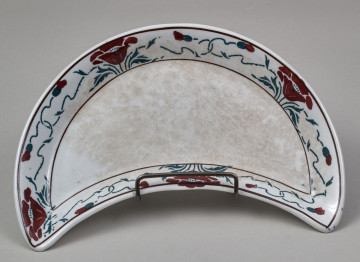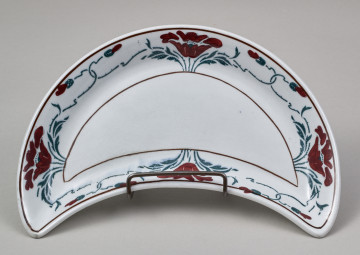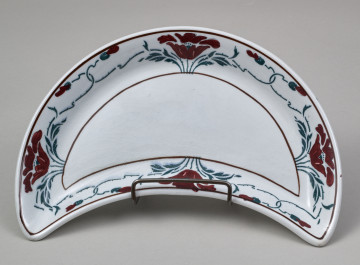
Appetiser plate
początek XX w.
Castle Museum in Łańcut
Part of the collection: ceramics
A yellowish faience appetiser plate in the shape of a crescent-shaped, shallow trough, adapted to be placed alongside a round, shallow plate. The plate’s well is flat, while the lip is steep, that is, inclined outward. The lip is decorated with a type of border featuring a two-tone poppy pattern (flower petals in burgundy-red, stems and leaves in dark sea green), stylised in the spirit of moderate Art Nouveau. The pattern consists of four cup-shaped flowers standing between pairs of leaves (corresponding to axial points), interlinked and at the same time intersected by two flower buds on long, winding stems, which loop and intertwine at their meeting point. The border is framed by two brown stripes, the thinner one outlining the plate’s well, and the thicker one running along the edge of the lip. The design was painted semi-mechanically using a stencil, the so-called pouncing. The leaves and stems were applied directly through the stencil using an underglaze dark green paint. The flower petals, however, were painted free-hand, also with an underglaze burgundy-red paint. The surface of the plate is covered with a fine grid of glaze cracks. On the underside of the plate are two signatures in green, stamped print. One features an anchor mark within an oval, with the inscription S.B. and S /ENGLAND underneath, the other is the signature of the London store SOUTH AUDLEY ST/ T. GOODE & Co/ LONDON. W. Noteworthy here are the clearly visible blue underlayers of the floral pattern, clearly visible from beneath the green parts. This is particularly present on the shorter section of the lip. The second characteristic is the optical reduction of the plate's well plane, by moving the line of the brown stripe outlining its field, across the refraction boundary of the well into the curve of the lip. The stripe is otherwise guided by an indecisive hand, frequently deviating from its intended path. Next to the signatures, there is the flower painter's mark in the form of a hand-painted number "2" in burgundy.
Joanna Kluz
Author / creator
Object type
Ceramics
Material
faience
Creation time / dating
Creation / finding place
Owner
Muzeum - Zamek w Łańcucie
Identification number
Location / status

początek XX w.
Castle Museum in Łańcut

początek XX w.
Castle Museum in Łańcut

początek XX w.
Castle Museum in Łańcut
DISCOVER this TOPIC
Castle Museum in Łańcut
DISCOVER this PATH
Educational path